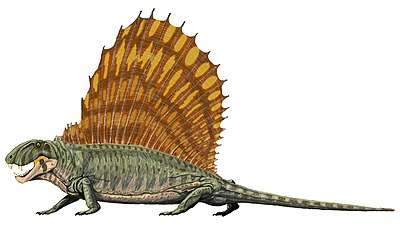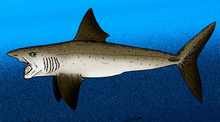Cisuralian
The Cisuralian is the first series/epoch of the Permian. The Cisuralian was preceded by the Pennsylvanian and followed by the Guadalupian. The Cisuralian Epoch is named after the western slopes of the Ural Mountains in Russia and Kazakhstan and dates between 298.9 ± 0.15 – 272.3 ± 0.5 Mya.[2]
| Cisuralian Epoch 298.9–272.95 million years ago | |
Ages in the Cisuralian -300 — – -298 — – -296 — – -294 — – -292 — – -290 — – -288 — – -286 — – -284 — – -282 — – -280 — – -278 — – -276 — – -274 — – -272 — Ages of the Cisuralian. Axis scale: millions of years ago. |
| System/ Period |
Series/ Epoch |
Stage/ Age |
Age (Ma) | |
|---|---|---|---|---|
| Triassic | Lower/ Early |
Induan | younger | |
| Permian | Lopingian | Changhsingian | 251.902 | 254.14 |
| Wuchiapingian | 254.14 | 259.1 | ||
| Guadalupian | Capitanian | 259.1 | 265.1 | |
| Wordian | 265.1 | 268.8 | ||
| Roadian | 268.8 | 272.95 | ||
| Cisuralian | Kungurian | 272.95 | 283.5 | |
| Artinskian | 283.5 | 290.1 | ||
| Sakmarian | 290.1 | 295.0 | ||
| Asselian | 295.0 | 298.9 | ||
| Carboniferous | Pennsylvanian | Gzhelian | older | |
| Subdivision of the Permian system according to the ICS, as of 2017.[1] | ||||
The Cisuralian is often synonymous with the informal terms early Permian or lower Permian.
The series saw the appearance of beetles and flies and was a relatively stable warming period of about 21 million years.
Name and background
The Cisuralian is the first series or epoch of the Permian.[3] The Cisuralian was preceded by the last Pennsylvanian epoch (Gzhelian) and is followed by the Permian Guadalupian epoch.
The name "Cisuralian" was proposed in 1982,[4] and approved by the International Subcommission on Permian Stratigraphy in 1996.[5] The Cisuralian Epoch is named after the western slopes of the Ural Mountains in Russia and Kazakhstan.[6][7][8]
Limestones on the edge of Russian Platform and make up the Ishimbay oil fields. These oil fields were vital to the Soviet Union during WW2 when the Germans controlled the oil fields to the west.[6]
The International Chronostratigraphic Chart (v2018/07)[3] provides a numerical age of 298.9 ± 0.15 – 272.3 ± 0.5 Mya.[9]
The base of the Cisuralian series and the Permian system is defined as the place in the stratigraphic record where fossils of the conodont Streptognathodus isolatus first appear. The global reference profile for the base (the GSSP or golden spike) is located in the valley of the Aidaralash River, near Aqtöbe in the Ural Mountains of Kazakhstan.[10]
Geography

Gondwana collided Laurussia and created the Alleghenian orogeny in present-day North America.[6] In northwestern Europe the Hercynian orogeny continued.[6] This created the large supercontinent, Pangea by the middle of the Early Permian Epoch which was to have an impact on the climate.[6]
Climate
At the start of the Permian, the Earth was still in an ice age, which began in the Carboniferous. Glaciers receded around the mid-Permian period as the climate gradually warmed, drying the continent's interiors.[11]
Biodiversity

The swampy fringes were mostly ferns, seed ferns, and lycophytes. The series saw the appearance of beetles and flies.[6]
The coal swamps from the Carboniferous continued and the herbivores, Diadectes and Edaphosaurus.[7] The dry interior with small insectivores. Caseids and proto-therapsid Tetraceratops made their appearance.[7] The marine life was probable more diverse than modern times as the climate warmed.[6] Unusual sharks such as Helicoprion continued in this series.

Early Permian terrestrial faunas were dominated by pelycosaurs, diadectids and amphibians,[12][13] The pelycosaurs appeared during the Late Carboniferous and reached their apex in the Cisuralian remaining the dominant land animals for some 40 million years.[7] A few continued into the Capitanian. They were succeeded by the therapsids.[7]
Subdivisions
Global
- Asselian stage (298.9 ± 0.15 – 294.6 ± 0.8 Mya)
- Sakmarian stage (294.6 ± 0.8 – 290.1 ± 0.7 Mya)
- Artinskian stage (290.1 ± 0.7 – 283.5 ± 0.7 Mya)
- Kungurian stage (283.5 ± 0.7 – 272.3 ± 0.5 Mya)
Regional
- New Zealand
- Telfordian (289 – 278 Mya)
- Mangapirian (278 – 270.6 Mya)
References
- "Chart/Time Scale". www.stratigraphy.org. International Commission on Stratigraphy.
- Gradstein, Felix M.; Ogg, James G.; Smith, Alan G. (2004). A Geologic Time Scale 2004. ISBN 9780521786737.
- International Commission on Stratigraphy. "Chart". Retrieved 10 July 2018.
- Gradstein, Felix M.; Ogg, James G.; Smith, Alan G. (2004). A geologic time scale 2004. Cambridge University Press. p. 250. ISBN 978-0-521-78673-7.
- Ganelin, V.G.; Goman'kov, A.V.; Grunt, T.A.; Durante, M.V. (January 1997). "On the revised stratigraphic scale for the Permian System adopted at the Second Guadalupian Symposium, alpine, Texas, USA, April 1996". Stratigraphy and Geological Correlation. 5 (2): 126–130.
- Ross, June R.P.; Ross, Charles A. (16 October 2018). "Permian Period". Encyclopædia Britannica. Retrieved 18 April 2019.
- Kazlev, M. Alan (4 May 2002). "The Cisuralian Epoch". palaeos.com. Retrieved 18 April 2019.
- Allaby, Michael (2015). A Dictionary of Geology and Earth Sciences (4th ed.). Oxford University Press. doi:10.1093/acref/9780199653065.001.0001. ISBN 9780199653065.
- International Commission on Stratigraphy. "GSSPs". Retrieved 10 July 2018.
- Davydov, V.I.; Glenister, B.F.; Spinosa, C.; Ritter, S.M.; Chernykh, V.V.; Wardlaw, B.R. and Snyder, W.S.; 1998: Proposal of Aidaralash as Global Stratotype Section and Point (GSSP) for base of the Permian System, Episodes 21(1): pp 11–18.
- Palaeos: Life Through Deep Time > The Permian Period Archived 2013-06-29 at the Wayback Machine Accessed 1 April 2013.
- Huttenlocker, A. K., and E. Rega. 2012. The Paleobiology and Bone Microstructure of Pelycosaurian-grade Synapsids. Pp. 90–119 in A. Chinsamy (ed.) Forerunners of Mammals: Radiation, Histology, Biology. Indiana University Press.
- "NAPC Abstracts, Sto – Tw". berkeley.edu.